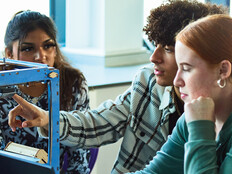There needs to be a cross-section of kids. Students who aren’t doing well — even those who have dropped out — need to be active participants in this conversation about why the model might be working for some but not for others.
The second thing is, early on, folks were just throwing classroom tools, such as interactive whiteboards, into classrooms and calling it a “student-centered environment.” But CIOs found that schools were using these whiteboards as glorified projectors.
So the questions schools need to ask are: How can we shift current teaching models to make sure that the technology investments we make are ones students will actually use? What is it going to take to enable a student-centered model, and who needs to be touching the technology in the classroom? Because when the adults are the only ones touching it, the model really doesn’t change.
EDTECH: You said schools need to develop technology coaches. What steps are needed to train teachers to be effective coaches?
Garry: Well, first of all, we’re trying to get away from using the term “technology coach” and just use the word coach instead.
The goal is to have someone who can direct users in the district, whether they call you for data coaching or technology coaching. Across these topics, the training processes should be similar.
Schools need to be able to measure the impact of the coaches they have, which means there needs to be consistency in the language and the processes that these coaches use.
Second, let’s say I’m a fifth grade teacher. I have access to three different coaches, and they all coach in different ways. It can be very hard to understand which person to listen to.
It’s important to operationalize the coaching and training process to make sure coaches can teach educators about how technology enhances learning, instead of coaches just being the gadget person.
EDTECH: When designing a digital transformation project in K–12, it’s important to consider how integrations will help all students succeed. How can schools ensure their projects help with classroom equity?
Garry: I think the No. 1 thing is professional development for teachers about voice and choice in the learning process. It’s the key to creating agency for all learners.
We ask district leaders, Have you defined equity? What does that look like? We’re doing a lot of consulting on what a model for equity looks like and how technology actually supports that.
So, for example, what we find, especially among school districts with one-to-one programs, is when a laptop or Chromebook goes home with a student, many kids don’t have access.
Right now, many districts work with public libraries or even the local McDonald’s — places where kids hang out — to make sure students have Wi-Fi access and that it’s safe and secure.
Students should have an equal opportunity to learn, especially if schools are giving them devices and encouraging them to bring the devices home.











